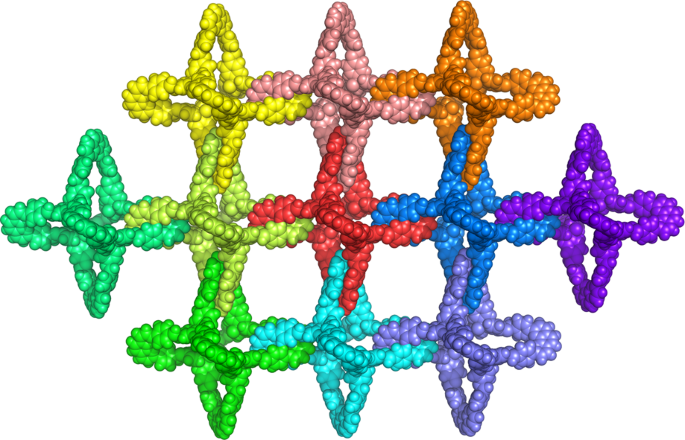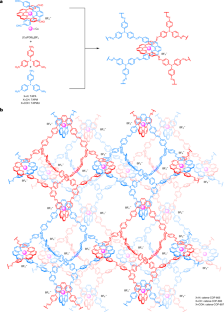2023-01-18 カリフォルニア大学バークレー校(UCB)
フランスの化学者ジャン=ピエール・ソバージュは、2つの連結した環である最初のカテナンの合成で、2016年のノーベル化学賞を共有しました。これらの構造は、しばしば分子機械と呼ばれる移動可能な分子構造を作るための基礎となった。しかし、カテナンの化学合成には、依然として手間がかかる。カテナンの環を1つ増やすごとに、もう1回化学合成をしなければならないのだ。ソバージュが2つの環を持つカテナンを作ってから24年、化学者たちはせいぜい130個の環を織り交ぜた程度で、電子顕微鏡でなければ見えないほど微量であった。
今回、カリフォルニア大学バークレー校のOmar Yaghi教授の研究室で作られた新型のカテナンは、3次元的に連結したユニットを無制限に作ることが可能である。個々のユニットは化学結合でつながっているのではなく、機械的に連動しているため、構造体は壊れることなく曲げることができる。
第一著者であるカリフォルニア大学バークレー校の博士研究員Tianqiong Ma氏を含むYaghi氏とその同僚たちは、この化学プロセスの詳細を学術誌『Nature Synthesis』に報告しました。カテナンを作るために、Yaghi教授とMa教授は、銅原子で共有結合された2つの同じ部分が交差している分子を合成した。その構造は、カテナCOFと呼ばれるもので、銅原子を交差させた2つのブーメランを連想させるものである。この分子を混ぜ合わせると、ビルディングブロックが連なった多孔質の3Dネットワークが形成される。このビルディングブロックは、アダマンタンという種類の多面体分子で、実質的に6本の腕をロックして拡張されたフレームワークを形成している。
交差を持つ分子は、最終的なカテナンが特定の化合物と相互作用するように、化学的に変化させることができる。Yaghiは、これらの材料を、無限大を表す記号を使って、(∞)カテナンと呼んでいます。
「これは、特定の運動などの刺激に反応して曲げたり硬くしたりできる材料を作るための第一歩だと思います」と彼は言う。「つまり、ある方向には非常に柔軟で、他の方向には硬くなる可能性があります。
<関連情報>
- https://news.berkeley.edu/2023/01/18/new-chain-mail-material-of-interlocking-molecules-is-tough-flexible-and-easy-to-make/
- https://www.nature.com/articles/s44160-022-00224-z
多面体からなるカテナイド型共有結合性有機フレームワーク Catenated covalent organic frameworks constructed from polyhedra
Tianqiong Ma,Yi Zhou,Christian S. Diercks,Junpyo Kwon,Felipe Gándara,Hao Lyu,Nikita Hanikel,Pilar Pena-Sánchez,Yuzhong Liu,Nicolas J. Diercks,Robert O. Ritchie,Davide M. Proserpio,Osamu Terasaki & Omar M. Yaghi
Nature Synthesis Published:16 January 2023
DOI:https://doi.org/10.1038/s44160-022-00224-z


Abstract
Although the synthetic chemistry leading to interlocking molecular [n]catenanes of organic polyhedra (n = 2–3) and rings (n = 2–130) is established, the analogous chemistry that pertains to infinite three-dimensional systems ([∞]catenane) remains undeveloped. We report a series of [∞]catenane covalent organic frameworks (termed catena-COFs). These were synthesized by linking 4,4′-(1,10-phenanthroline-2,9-diyl)dibenzaldehyde to either of tris-(4-aminophenyl)-amine, -methane or -methanol through imine condensation. These combinations give discrete adamantane-like polyhedra, catenated by virtue of the copper(I) ions templating a mutually embracing arrangement of PDBs (points-of-catenation), which ultimately results in infinite catena-COF-805, 806 and 807. The crystal structures of these COFs obtained from electron microscopy and X-ray diffraction were determined to be isoreticular and to adopt the bor-y structure type.




